Masks were not the only items being wiped off shelves at the peak of the COVID-19 pandemic – sales for air purifiers skyrocketed too and revenue is now estimated to reach 20.3 billion USD globally by 2028.
The increasing awareness of personal hygiene and health fuelled by the pandemic is one of the driving factors of the growth. But even as the pandemic eased, air purifiers have still been gaining steady popularity worldwide including in Singapore to combat a host of other issues like air pollution.
As such, more and more variations of air purifiers have sprung up in a bid to meet the demand. Unfortunately, the overwhelming number of options to choose from has also caused much confusion for consumers.
If you are one of the bewildered consumers looking to purchase one for your home or office, this guide to everything you need to know about air purifiers will come in handy.
Keep reading to find out the importance of air purifiers and how you can choose the perfect one for your needs.
Part 2 – The ABCs of Air Purifiers
2.1 What is the difference between an air purifier and an air ionizer?
While both an air purifier and an air ionizer are both air cleaners designed to capture airborne particles, they utilise different technologies that have an impact on the effectiveness of the device.
Air purifiers cleanse the air by trapping them while air ionizers release negatively charged ions that bind to particles and pollutants. However, the latter causes particles to become heavier and land on surfaces, which you will then have to sweep up to remove from the room eventually. Some ionizers may also emit ozone which can be harmful to your health, causing issues like coughing and respiratory infections.
For a safer choice and less hassle, consider opting for an air purifier instead.
2.2 How does an air purifier work?
Unlike an air ionizer, air purifiers make use of a filtration system to pull in and trap unwanted particles, before releasing clean air to be circulated back into the room. The filtration process repeats a few times in an hour, boosting indoor air quality continuously.
The exact particles removed will depend on the type of air purifier you choose and the specific filter it uses. Hence, pay more attention to the nitty-gritty details of the purifier’s specifications to help you determine if it is able to meet your needs.
2.3 Are air purifiers really effective?
Despite being dubbed an indispensable device to have in the home or office, many still have doubts about whether an air purifier is really as effective as it claims.
Although there is little medical evidence that using an air purifier will drastically improve your health, it is still a nifty device to have to boost the air quality of a space, which can enhance your quality of life.
An air purifier is effective in eliminating common airborne household allergens and particles, like smoke and dust, which may help you to breathe better if you suffer from allergies or asthma. Apart from allergens, air purifiers can also capture mould spores in the air to prevent them from spreading further. When used properly, an air purifier can reduce airborne contaminants including viruses.
Many office buildings are also designed with windows that cannot be opened, resulting in decreased airflow and causing pollutants to be trapped. This is when an air purifier comes into play as well – it provides artificial ventilation to cleanse polluted indoor air for fresher-smelling offices.
Additionally, many air purifiers available on the market in Singapore now come with sensors that will tell you more about indoor air quality, prompting you to start doing something when the numbers get too high.
While removing the source of pollutants and using outdoor air to ventilate your home or office may be the best method for fresher and cleaner air, adding an air purifier into the mix will help to maintain the quality of indoor air.
Alas, like any other device, an air purifier has its limitations too – it cannot keep your home free of germs and guarantee 100% clean and quality air, for example. But if you are looking to improve indoor air quality and have reasonable expectations, you will surely reap the benefits of using an air purifier.
2.4 What are the benefits of using an air purifier?
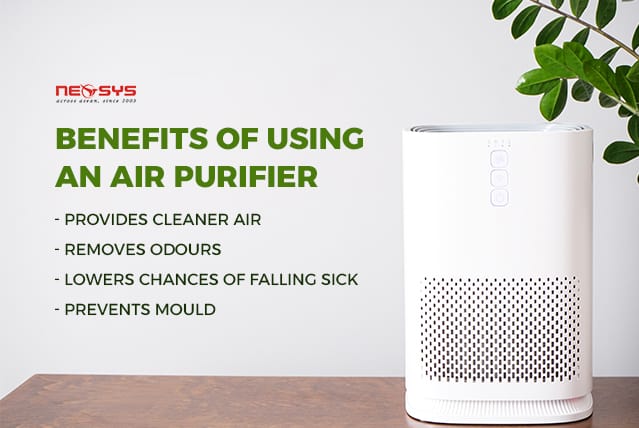
Even though different air purifiers use different filters, they all offer similar benefits at the end of the day. Here are some of the most common advantages that will convince you to give an air purifier a try.
- Provides cleaner air
The air we breathe in is the basic element of life and essential for the functioning of every single cell in our body. Thus, quality air that is free of pollutants such as pollen, dander, dust and smoke is important. Air purifiers capture particles to ensure that indoor air quality is consistently at a healthy range to reduce the chances of breathing issues, which will be extra beneficial if you suffer from asthma and allergies that are easily triggered by pollutants.
- Removes odours
It is well known that air purifiers capture allergens, but not many know that certain purifiers can help to reduce odours as well. The key is to look for an air purifier with an activated carbon filter – it cleanses chemical contaminants not just to eliminate odours, but also to reduce your risk of developing serious health conditions. The carbon filtering method traps chemicals and neutralises unpleasant odours before circulating fresh air back into the room, perfect for a home or office that has just undergone renovations, for instance.
- Lowers chances of falling sick
The common cold and flu can be spread through airborne particles, which is why you may notice employees sitting near a sick colleague or family members who live in the same space falling sick one after the other. Although an air purifier cannot guarantee the removal of all airborne viruses and bacteria, it can reduce your chances of falling sick. This is especially crucial if you live with the elderly or children with weakened immune systems.
- Prevents mould
Mould can invade spaces and spread rapidly, causing damage to structures and furniture as well as the human body with long-term exposure. Thankfully, even though an air purifier is not able to treat active mould, it can capture airborne mould particles to prevent further damage and spreading.
2.5 Tell-tale signs you need to invest in an air purifier
Still not convinced that you need a home or office air purifier? Look out for these tell-tale signs that it is high time to invest in one.
- The air in your home or office smells stale and musty
- You see dust mites everywhere, on furniture and surfaces
- You are experiencing more asthma flare-ups than usual
- You have allergy symptoms like a stuffy nose and itchy eyes
- You cannot stop sneezing or coughing in your home or office
- Your family members or employees are falling sick more frequently
- You use disinfectants often
Part 3 – Choosing the Perfect Air Purifier
3.1 Understanding the different types of air purifier filters
Before you jump the gun to purchase your very first air purifier, it is vital for you to understand the different types of filters available and what they do so that you make informed choices.
Here are the five common air purifier filters you need to know.
1. HEPA filter
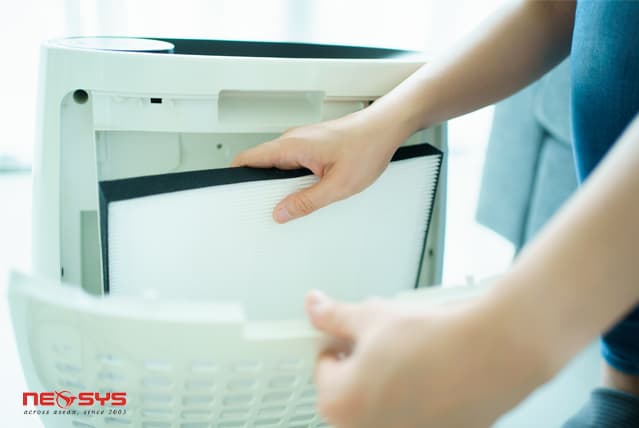
A high-efficiency particulate air (HEPA) filter is a disposable and dry-type filter that can remove up to 99.97% of particles that are small as 0.3 microns. Most HEPA filters for air purifiers are made from a mixture of interlaced glass fibres and come in different grades that cater to a variety of scenarios. The higher the grade, the better the performance – H10 to H12 HEPA filters trap fewer particles than their higher-grade counterparts; H13 and H14 HEPA filters are considered ‘medical-grade’ and have the ability to filter 99.95% and 99.995% of all particles down to 0.3 microns respectively.
Learn more: HEPA Filters for Air Purifiers: Different Grades & Which to Choose
2. UV light filter
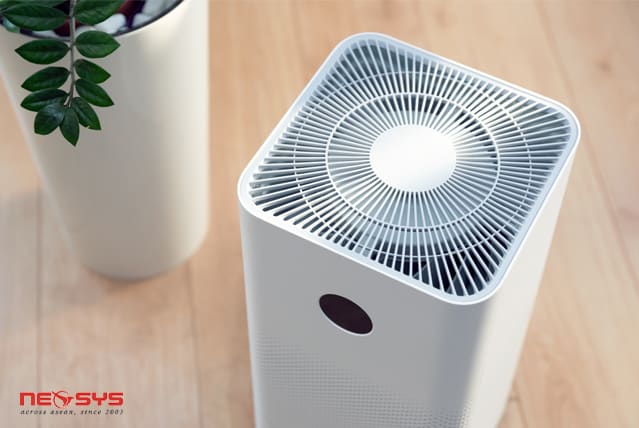
Germicidal radiation from a UV lamp disinfects air as it passes through the filter, killing bacteria and viruses. The downside is that UV filters may convert oxygen molecules into ozone molecules which can cause health concerns like coughing. Hence, most air purifiers using UV light filters are generally accompanied by more advanced filtration systems like the HEPA filter for optimum results.
3. Electrostatic filter
Like its name suggests, an electrostatic filter creates static electricity to give particles a positive charge as they enter the filter. This charge is then released as the air continues through layers of the filter, allowing particles to be trapped successfully. It is especially useful in trapping allergens like pollen, dander and dust, and has washable and disposable variations. Some of these air purifiers come with a carbon filter to improve their efficiency too.
4. Carbon filter
A carbon filter uses activated carbon to trap chemicals and gases by absorbing and neutralising the particles, making it most suitable for use in environments where chemicals are present. For example, if you use disinfectants to clean your home or office regularly, an air purifier with a carbon filter can help to speed up the removal of chemicals in the space. Most carbon filters are used in conjunction with other filtration systems like a HEPA filter for best results.
5. Washable filter
Choosing a washable filter is a fuss-free option as it can be easily vacuumed or rinsed to remove dirt and trapped impurities. It is also more environmentally friendly and cost-effective than disposable filters. However, a washable filter cannot remove or reduce odours, and only works on dust and other contaminants. If you need an air purifier to perform more than just trapping primary pollutants, choosing a HEPA filter may be a better choice.
Each type of filter has its pros and cons – some are more effective than others while some are only able to filter pollutants but not odours.
There is no one size fits all solution when it comes to choosing an air purifier, but it is most important to evaluate which filter will fit right into your lifestyle and meet your checklist.
3.2 Strategic areas to place an air purifier in your home or office
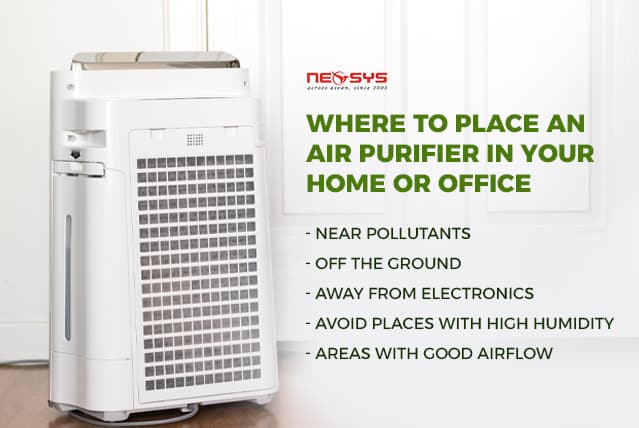
Noticed that your air purifier is not doing its job of cleansing the air like what you had hoped for? Or feeling unsure about where you can place your newly bought purifier in your home or office?
To get the most out of your air purifier, there are some rules to follow and specific locations or positions to take note of to enhance its effectiveness.
- Near pollutants
While it may sound like a no-brainer to place an air purifier near pollutants, you will be surprised to see how many are tucked away in corners just so they go with the aesthetic of the space. Caring more about how an air purifier will look in the room than how effectively it is able to cleanse the air is like throwing money down the drain.
Thus, make sure you place your air purifier in areas of your home or office where the concentration of pollutants such as smoke, odour and mould, is at its highest. You do not need a professional to tell you where these problem areas are – use your senses to identify them as you should be able to easily see pollutants like smoke and mould and smell foul odours.
- Off the ground
Another common mistake is placing an air purifier on the ground which will have a huge impact on the effectiveness of the device. As air circulates both horizontally and vertically, elevating your air purifier no higher than 5 feet off the ground will help to ensure purified air is able to circulate vertically as well.
Simply place it on a piece of furniture like a dresser or look for a mountable air purifier to save space.
- Away from electronics
Avoid placing your air purifier near electronics not just to stave off interference, but also to make certain that no other objects are in the way of airflow.
This simple trick goes a long way as it prevents unnecessary downtimes and gives the purifier ample space to maximise its efficiency.
- Avoid places with high humidity
The bathroom and kitchen are high in humidity, which also means the air in these places is heavier. Humid air hinders the capability of air purifiers and results in more energy needed to create airflow. Naturally, humid places are also a breeding ground for mould which is why using a dehumidifier might be a better choice.
Therefore, place your air purifier in rooms with low humidity instead so that the capacity of filters will not be affected.
- Opt for areas with good airflow
While air purifiers in Singapore are capable of sucking in the air effectively, placing them near areas with high airflow can help expedite air intake and enable them to clean the air more quickly.
Position your air purifier near doorways and windows so it can filter the air as it comes, minimising the chances of pollutants being scattered around your home.
3.3 Air purifier jargon and what you need to look out for
Now that you have a deeper understanding of air purifier filters and the best areas to place the device, the final step is to grasp the common jargon and acronyms used so you know what to look out for.
- Air change rate per hour (ACH)
One of the least understood ratings on air purifiers but essential to know, ACH refers to how many times the total volume of air in a room gets completely filtered within an hour. For instance, an ACH value of 5 means that your room’s entire volume of air is cleaned 5 times in one hour.
Depending on your lifestyle and needs, an ACH value of 2 should suffice but if you have allergies or are a smoker, choosing an air purifier with an ACH value of 5 and above will help to filter the air more efficiently.
- Minimum efficiency reporting value (MERV)
A MERV rating determines how well an air purifier filter captures particles – the higher the value, the greater the percentage of particulate matter caught. For example, a MERV 16 rating is able to capture more than 95% of particles.
According to the National Environment Agency, a minimum MERV 14 rating is recommended to mitigate COVID-19 aerosol transmission risk.
- Clean air delivery rate (CADR)
CADR refers to the volume of air in cubic feet per minute (CFM) that is rid of particles in certain sizes. Three types of pollutants – smoke, pollen and dust – are tested to represent small, medium and large-sized particles.
Thus, when looking for an air purifier, you need to know your room’s specifications to be able to calculate the CADR that is suitable for the space. Here is how:
-
- – Calculate the room size using length x width x height
- – Identify the ACH value
- – Take room size multiplied by ACH value, then divided by 60
3.4 Answering frequently asked questions about air purifiers
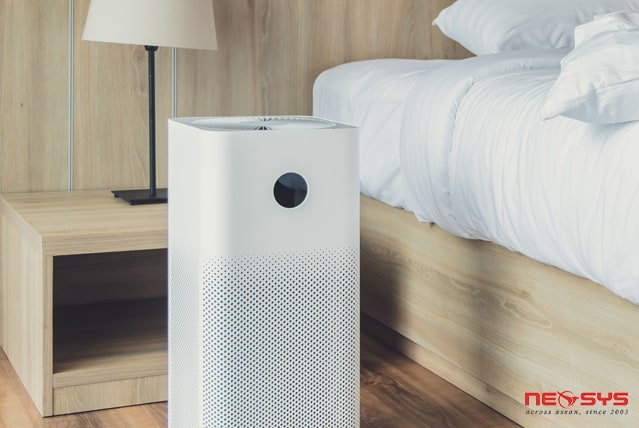
Here are some frequently asked questions about air purifiers answered to give you greater peace of mind or help you take the leap of faith if it is your first time investing in a purifier.
1. Is it safe to leave an air purifier on 24/7?
Yes, most air purifiers are generally safe to be left on all day especially if it uses a HEPA filter. However, it is important to clean the filters regularly to ensure the air quality is not compromised and that the air purifier offers optimal results.
2. How long does it take for an air purifier to work?
On average, an air purifier can cleanse the air in a small room in 30 minutes but can take up to hours in a larger room. How quickly it works also depends on a few factors, like the ACH value, power settings and type of filter used.
3. How often should I change or wash the filter?
The frequency will vary according to the type of filter you are using, the size of your air purifier and the air quality. It is recommended that you refer to the manufacturer’s instructions, but a rule of thumb for most HEPA filters is to replace them every 6 to 12 months.
4. What happens if I do not change or wash the filter in my air purifier?
Allowing your filter to clog up could lead to serious issues, such as being a breeding ground for germs and mould. The air purifier’s motor might become taxed to the point of breaking down as well. It also reduces the purifier’s effectiveness and you may notice an increase in allergens and odours.
5. Are air purifiers noisy?
Although air purifiers are not the noisiest device out there, their internal fans can produce a fair bit of noise. But there is always the option to adjust the fan setting to a lower mode or opt for an air purifier with a noise level setting.
6. Can I open my windows when an air purifier is running?
Opening the windows when an air purifier is running will not affect its efficacy as it will purify the air flowing in to offer you higher indoor air quality.
Neosys – the one-stop platform for air purifiers in Singapore
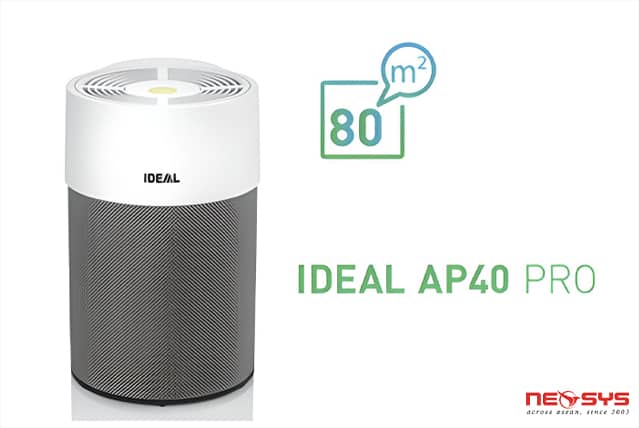
Clean and high-quality indoor air is just a few steps away with Neosys! Our wide selection of air purifiers available in Singapore filter nearly 100% of the smallest particles and pathogenic germs before they reach your airways.
Choose from purifiers with intelligent sensor technology, low power consumption and robust HEPA filters. They come in a range of sizes to cater to different scenarios so that there is something for every space and everybody.
While you are at it, consider getting our car air purifier that will help you to enjoy a safer and cleaner driving experience. The activated carbon filter absorbs dangerous chemicals, odours and volatile organic compounds so you can drive in peace.
Learn more: 6 Reasons Why Your Car Needs an Air Purifier Too
